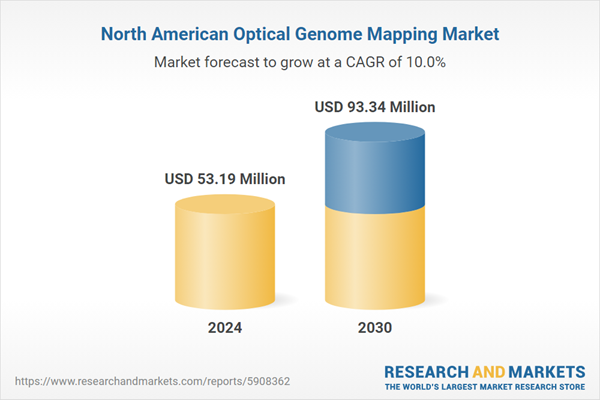Speak directly to the analyst to clarify any post sales queries you may have.
10% Free customizationThis report comes with 10% free customization, enabling you to add data that meets your specific business needs.
The North America Optical Genome Mapping Market has experienced robust growth in recent years, driven by increasing applications in genomics research, growing prevalence of chronic diseases, riisng aging population, clinical diagnostics, and biotechnology. The market's growth is attributed to advancements in technology, expanding research initiatives, and a growing awareness of the potential of optical genome mapping. The market size is substantial and is expected to continue expanding as the technology becomes more accessible and integrated into various scientific disciplines.
Key Market Drivers
Advancements in Genomic Research
Advancements in genomic research have emerged as a critical and compelling driver for the growth of the North America Optical Genome Mapping Market. Genomic research refers to the study of an organism's complete set of DNAS, encompassing its genes and non-coding sequences, to understand the genetic basis of various biological processes, diseases, and traits. Optical genome mapping is an advanced technology that plays a pivotal role in this domain by facilitating the high-resolution mapping of DNA molecules. Genomic research has evolved significantly in recent years, primarily driven by the introduction of high-throughput sequencing technologies, such as Next-Generation Sequencing (NGS).While NGS is excellent for sequencing DNA, it has limitations in accurately detecting structural variations in the genome. This is where optical genome mapping comes into play. It provides researchers with a complementary tool to investigate the structural complexities of genomes. As researchers strive to understand the full spectrum of genomic variations, optical genome mapping offers a unique advantage by revealing large-scale structural changes, such as copy number variations (CNVs), translocations, and inversions. These insights are crucial for deciphering the genetic basis of diseases and traits. For instance, in January 2024, NVIDIA unveiled a new GPU-accelerated platform designed for genomic data processing and analysis, enabling healthcare providers to enhance their services and improve patient outcomes.
Key Market Challenges
High Initial Capital Investment
The adoption of optical genome mapping technology often requires a significant initial capital investment. The cost of acquiring the necessary equipment, setting up a laboratory infrastructure, and training personnel can be substantial. Many research institutions, clinical laboratories, and smaller companies may find it financially challenging to make such investments. This barrier to entry can limit the market's growth, particularly among smaller organizations with limited budgets.Key Market Trends
Integration with Multi-Omics Approaches
A notable trend in the optical genome mapping market is the integration of optical genome mapping data with other "omics" data types, such as genomics, transcriptomics, proteomics, and epigenomics. This trend aligns with the broader shift toward multi-omics approaches in life sciences research. Researchers are increasingly recognizing the value of combining multiple layers of biological information to gain a more comprehensive understanding of complex biological systems and diseases.Optical genome mapping provides structural insights into DNA, which can be integrated with other omics data to uncover connections between genomic alterations and gene expression, protein function, and epigenetic modifications. This holistic approach enhances researchers' ability to identify causal relationships, biomarkers, and therapeutic targets. As a result, the integration of optical genome mapping with multi-omics strategies is expected to drive its adoption in genomics research and personalized medicine.
Key Market Players
- Bionano Genomics, Inc., US
- NabSys Inc., US
- Nucleome Informatics Pvt Ltd
- France Genomique
- Praxis Genomics
- PerkinElmer
- OpGen, Inc
Report Scope:
In this report, the North America Optical Genome Mapping Market has been segmented into the following categories, in addition to the industry trends which have also been detailed below:North America Optical Genome Mapping Market, By Product:
- Consumables
- Instruments
North America Optical Genome Mapping Market, By Application:
- Genome Assembly
- Structural Variation Detection
- Microbial Strain Typing
- Haplotype Phasing
- Others
North America Optical Genome Mapping Market, By End-User:
- Research & Academic Institutions
- Biotechnology & Pharmaceutical Companies
- Clinical Laboratories
- Others
North America Optical Genome Mapping Market, By Country:
- United States
- Canada
- Mexico
Competitive Landscape
Company Profiles: Detailed analysis of the major companies present in the North America Optical Genome Mapping Market.Available Customizations:
With the given market data, the publisher offers customizations according to a company's specific needs. The following customization options are available for the report.Company Information
- Detailed analysis and profiling of additional market players (up to five).
This product will be delivered within 1-3 business days.
Table of Contents
Companies Mentioned
- Bionano Genomics, Inc., US
- NabSys Inc., US
- Nucleome Informatics Pvt Ltd
- France Genomique
- Praxis Genomics
- PerkinElmer
- OpGen, Inc.
Table Information
| Report Attribute | Details |
|---|---|
| No. of Pages | 120 |
| Published | March 2025 |
| Forecast Period | 2024 - 2030 |
| Estimated Market Value ( USD | $ 53.19 Million |
| Forecasted Market Value ( USD | $ 93.34 Million |
| Compound Annual Growth Rate | 9.9% |
| Regions Covered | North America |
| No. of Companies Mentioned | 7 |









